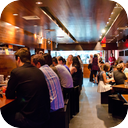(short preview of full seamless looping track)
Korean Restaurant
This product is not available in the selected currency.
In Stock
Backordered
Out of Stock
Description
A night out for some korean food can sum up almost any day. Korean cuisines originated from prehistoric traditions in the Korean peninsula evolving through a complex interaction of environmental, political, and cultural trends. At this point, the history of North and South Korea sharply diverged. In the 1960s under President Park Chung Hee, industrialization began to give South Korea the economic and cultural power it holds in the global economy today. Livestock and dairy production was increased during the 1970s through the increase of commercial dairies and mechanized farms.[93] The consumption of pork and beef increased vastly in the 1970s. Per-capita consumption of meat was 3.6 kg in 1961 and 11 kg by 1979. The result of this increased meat consumption brought about the rise of bulgogi restaurants, which gave the middle class of South Korea the ability to enjoy meat regularly. Meat eating continued to rise, reaching 40 kg in 1997, with fish consumption at 49.5 kg in 1998. Rice consumption continually decreased through these years, with 128 kg consumed per person in 1985 to 106 kg in 1995 and 83 kg in 2003. The decrease in rice consumption has been accompanied by an increase in the consumption of bread and noodles.
Opps
Sorry, it looks like some products are not available in selected quantity.



